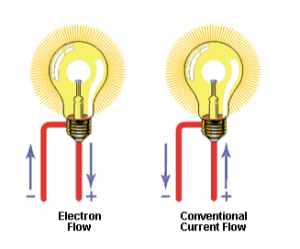What is Electricity, Drift Velocity and Electric Current?
Electricity is flow of free electrons and also called flow of charge. While doing so, it does work and has been made use during the last two centuries by scientists and engineers to help mankind. Electronic charge can be made to flow under the action of magnetic field associated with motion called electric generator, chemical action, and solar effect on semi conductor etc. Static electron produces electrostatic field giving rise to capacitive (storage) action whereas moving electron represent current and produces electro-magnetic field. During the passage of electric current for any purpose, both static and dynamic properties of electron come into role producing its desired and undesirable effect.
How the Electric current flows
As stated, electric Current relates to motion of charge. The electric current is defined as the rate of flow of charge per unit time. If Q is the amount of charge flowing through the conductor in t sec, the current is Q/t. SI unit of current is Ampere (A) named after the French scientist Andee Marie Ampere (1775-1836). Now 1 Ampere = 1 Coulomb/1 sec = 1Cs-1. Direction of current is opposite to the flow of current. Now it is important to understand that the current through the conductor is 1A when 1 C charge flows through the conductor in 1 sec.
Now current density at a point in the conductor is defined as the current per unit cross-section area and expressed by letter J. Current is a scalar whereas Current density is a vector quantity. J is thus I/A2. Current density is a property inside the conductor and even 5% variation of cross-section area at one location results in about 25% variation in current density.
Metallic conductors have large numbers of electrons free to move around and are called conduction electron or charge particles. At room temperature these conduction electrons moves randomly inside the conductor, colliding with protons randomly with nil net movement in a particular direction. Now what happens when a potential difference is applied across the conductor? Potential difference is an accumulation of charge particles of same polarity at end of the conductor. This potential difference sets up a field inside the conductor, producing a net force on the charge particles accelerating net motion in one direction. This motion results in drift velocity designated as vd.
Now let τ is the average time between two successive collisions and E is the strength of applied electric field then
- Force on electron due to applied electric field is F=eE (where e is the amount of charge on electron)
- Acceleration produced is given by a=eE/m (where m is the mass of electron)
- Additional velocity acquired by the electron is vd=aτ or vd=(eE/m)τ (when electron is accelerated for an average time interval τ)
This drift velocity is defined as the velocity with which free electrons gets drifted towards the positive end of the conductor under the influence of externally applied electric field.
Relation between drift velocity and electric current
Consider a conducting wire of length L and having uniform cross-section area A in which electric field E is applied. Let there are n free electrons per unit volume moving with a drift velocity vd. In the time interval δt, each electron advances by a distance vd δt and volume of this portion is Avd δt and no of free electron in this portion is nAvd δt and all these electrons crosses the area A in time δt.
- Charge crossing the area in time δt is
ΔQ=neAvd δt
or flow of current is
I= δQ/ δt =neAvd
This is the relation between the electric current and drift velocity. - If the moving charge carriers are positive rather than negative then electric field force on charge carriers would be in a direction of electric fields direction and drift velocity would be in direction opposite.
- In terms of drift velocity current density is given as J=I/A=nevd
This drift velocity is very small in value. Now for a copper conductor, current density of J=1.55×106A/m2, Number of free electrons n=1029 and charge on the electron is 1.6×10-19, then we get vd=J/ne = 1.55×106/ (1029x1.6×10-19) = 9.7×10-5 m/sec or 0.58 cm/min
This is contrary to the belief that the drift velocity may be very large and is the reason for immediate action on pressing the light switch.
How there is an immediate action on pressing the switch?
As soon as the light switch is made ON, an electric field is set up in the conductor at the velocity of light i.e. 3×108 m/s called velocity of propagation of electric field. This field sets in flow of charge particles at drift velocity and the nearest electron sets in the action.
You may also like:
- Selection of Suspension Arrangement of Traction Motors : A Right…
- Permanent Magnet Synchronous Motor
- Multiple Choice Question on Basic Concept of Science Class X…
- Current Developments in the field of Traction motors
- Selection of Suspension Arrangement of Traction Motors : A Right…
- Re-engineering of Stators of Three phase Traction Motors type 6FRA…
very nice article.useful information.Thanks a lot